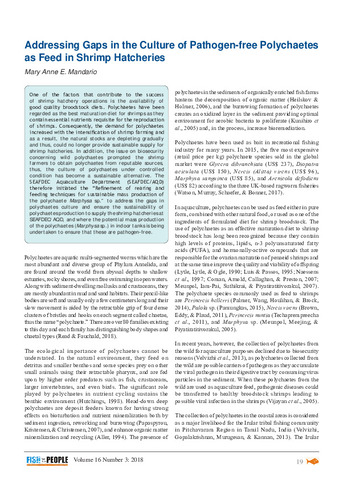Interaction effect of light intensity and photoperiod on egg hatchability, survival and growth of polychaete Marphysa iloiloensis from larva to juvenile
| dc.contributor.author | Mandario, Mary Anne | |
| dc.contributor.author | Castor, Nomae Joylyn T. | |
| dc.contributor.author | Balinas, Vicente T. | |
| dc.date.accessioned | 2020-09-10T06:34:08Z | |
| dc.date.available | 2020-09-10T06:34:08Z | |
| dc.date.issued | 2021 | |
| dc.identifier.citation | Mandario, M. A. E., Castor, N. J. T., & Balinas, V. T. (2021). Interaction effect of light intensity and photoperiod on egg hatchability, survival and growth of polychaete Marphysa iloiloensis from larva to juvenile. Aquaculture, 531, 735890. | en |
| dc.identifier.issn | 0044-8486 | |
| dc.identifier.uri | http://hdl.handle.net/10862/5992 | |
| dc.description.abstract | Polychaetes are of high commercial interest as potential feed in aquaculture industry. Despite this, knowledge of polychaete culture is limited. The goal of this study is to develop a protocol that maximizes survival and growth of polychaetes from embryonic to juvenile stages. To determine the effect of light intensity and photoperiod on Marphysa iloiloensis, two experiments were conducted; 1 - hatchability (embryo-larva; 24 h duration) and 2 - survival and growth (larva-juvenile; 29 d duration). Both experiments followed a 3 × 3 factorial design using three light intensities (3.4, 64.4, and 157 μmol m−2 s−1) and three photoperiods (1 L: 23D, 3 L: 21D, and 6 L: 18D) with four replicates each. The best light regime was compared to the control (0 μmol m−2 s−1). Hatching success was significantly lower in treatments exposed to 157 μmol m−2 s−1 regardless of photoperiod (P < 0.05). Survival at juvenile stage was significantly dependent on the interaction between light intensity and photoperiod (P < 0.01). Survival was higher in both 0 μmol m−2 s−1 and 3.4 μmol m−2 s−1 (all photoperiods). Survival decreased significantly in 64.4 μmol m−2 s−1 and 157 μmol m−2 s−1 under both 3 L: 21D and 6 L: 18D photoperiods. Prolonged exposure to higher light intensity compromised the survival of the polychaete from larval to juvenile stage while growth was not affected. These findings suggest that either continuous darkness or a light intensity of 3.4 μmol m−2 s−1 is the best culture condition from embryonic to juvenile stage of mud polychaete M. iloiloensis to optimize production. | en |
| dc.description.sponsorship | This study was funded by the Aquaculture Department, Southeast Asian Fisheries Development Center (SEAFDEC/AQD) under the study code Br-02-Y2016T. | en |
| dc.language.iso | en | en |
| dc.publisher | Elsevier | en |
| dc.subject | Polychaete | en |
| dc.title | Interaction effect of light intensity and photoperiod on egg hatchability, survival and growth of polychaete Marphysa iloiloensis from larva to juvenile | en |
| dc.type | Article | en |
| dc.identifier.doi | 10.1016/j.aquaculture.2020.735890 | |
| dc.citation.volume | 531 | |
| dc.citation.spage | 735890 | |
| dc.citation.journalTitle | Aquaculture | en |
| dc.subject.asfa | light intensity | en |
| dc.subject.asfa | photoperiodicity | en |
| dc.subject.asfa | interactions | en |
| dc.subject.asfa | eggs | en |
| dc.subject.asfa | survival | en |
| dc.subject.asfa | growth | en |
| dc.subject.asfa | aquaculture | en |
| dc.subject.scientificName | Eunicidae | en |
| dc.subject.scientificName | Marphysa iloiloensis | en |
| local.subject | Mudworm | en |
| local.subject | Polychaete culture | en |
このアイテムのファイル
| ファイル | サイズ | フォーマット | 閲覧 |
|---|---|---|---|
|
このアイテムに関連するファイルは存在しません。 |
|||
このアイテムは次のコレクションに所属しています
-
Journal Articles [1258]
These papers were contributed by Department staff to various national and international journals.




